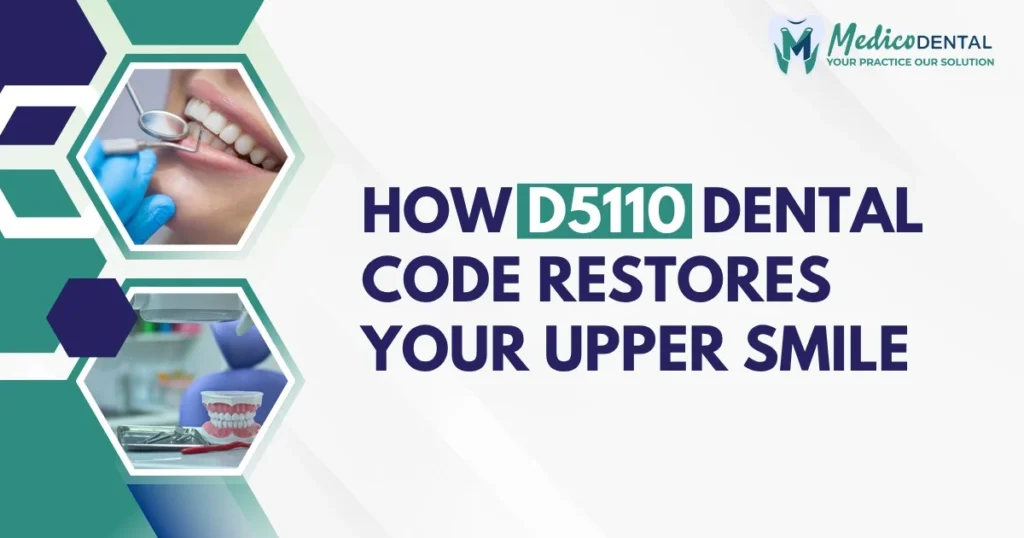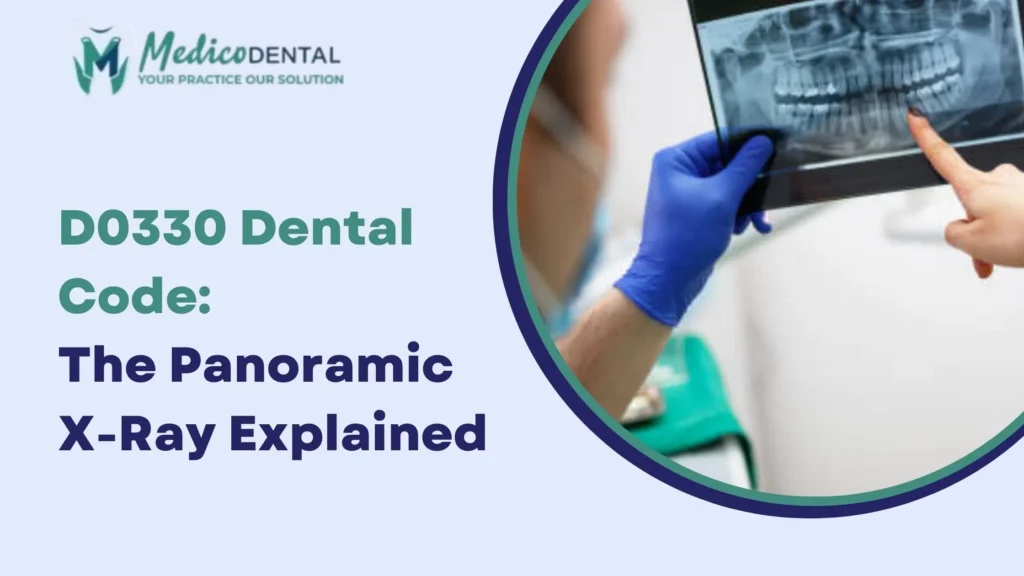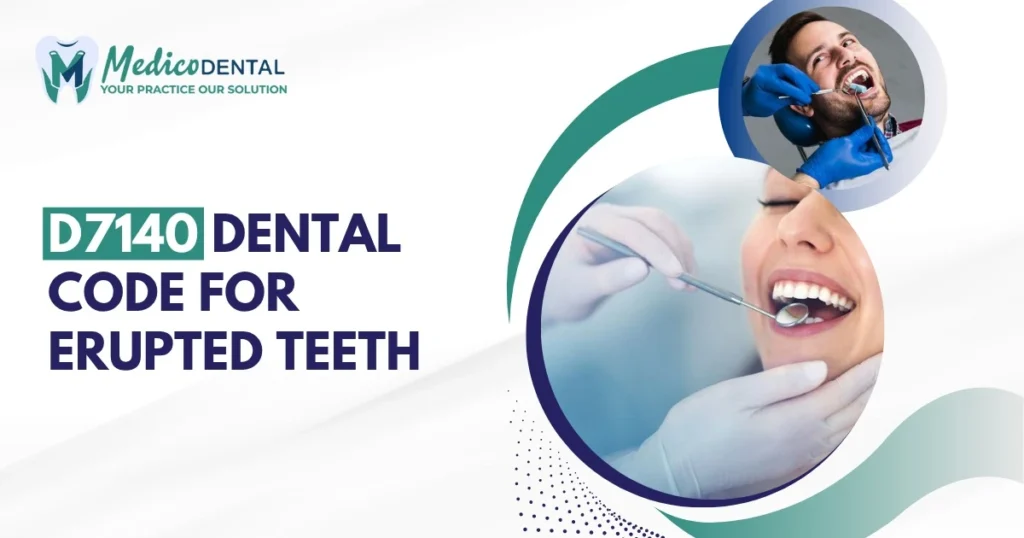If you’ve recently lost all the teeth in your upper jaw and are considering dentures, understanding the D5110 dental code is crucial. This code specifically refers to a complete maxillary denture, a removable appliance designed to replace all missing teeth in the upper jaw. In this guide, we’ll walk you through the services covered under this code, who is eligible for it, and the various factors that come into play when billing for a complete maxillary denture.
What is D5110 Dental Code?
Overview of D5110
The D5110 dental code is used to bill for the complete upper denture for patients who have lost all their upper teeth. This code includes the entire process from the initial consultation and impressions to the final placement and post placement adjustments. This procedure is typically recommended for patients who have lost all their upper teeth due to decay, periodontal disease, or injury.
D5110 is recognized by many dental insurance plans, making it an essential code for both dental professionals and patients seeking insurance reimbursement for this dental procedure. However, it is important to note that coverage may vary depending on the specific insurance policy.
Definition of Complete Maxillary Denture
A complete maxillary denture is a full set of artificial teeth designed to fit over the gums of the upper jaw. This removable appliance is custom made to replace all the teeth in the upper arch, helping patients regain their ability to chew, speak, and smile confidently. Dentures are designed to mimic the appearance and function of natural teeth, making them an essential solution for patients with complete tooth loss in the upper jaw.
Services Covered Under D5110 Dental Code
The D5110 dental code covers several key steps in the denture process. Each step is critical to ensuring that the final result meets the functional and aesthetic needs of the patient.
Examination and Evaluation
Before proceeding with the creation of a complete maxillary denture, a thorough examination and evaluation are essential. During this phase, the dentist assesses the patient’s oral health, checks for any remaining teeth or gum issues, and ensures that the patient’s jaw is in good condition to support the denture. This step helps the dentist determine if any additional treatments, such as gum care or tooth extractions, are necessary before proceeding with the denture process.
Impressions and Casts
Once the initial evaluation is complete, the dentist takes impressions of the patient’s upper jaw. These impressions are used to create an accurate cast of the patient’s mouth, ensuring that the denture fits comfortably and securely. The cast is essential for designing a denture that aligns with the natural contours of the gums and palate, preventing discomfort and improving functionality.
Fabrication and Placement of the Complete Denture
After the impressions are made, the denture is fabricated in a dental lab. This involves crafting the artificial teeth and the base of the denture, ensuring that they match the patient’s natural appearance and bite. Once the denture is ready, the dentist will fit it in the patient’s mouth, making adjustments to ensure proper alignment and comfort. The placement of the denture is a critical step to ensure that the patient can chew and speak properly.
Post placement Adjustments
After the denture is placed, post placement adjustments are often necessary to ensure the patient is comfortable. During follow up visits, the dentist checks for any signs of irritation, discomfort, or improper fit and makes the necessary changes. It may take a few appointments to ensure that the denture is perfectly suited to the patient’s mouth, with adjustments to the fit, bite, and aesthetics.
Indications for Using D5110
The D5110 code is typically used for patients who have lost all their teeth in the upper jaw and need a complete denture. Understanding the reasons behind this procedure can help patients determine if this is the right solution for them.
Patients Requiring a Complete Maxillary Denture
A complete maxillary denture is recommended for patients who have lost all their upper teeth. This could be due to several factors, including advanced tooth decay, gum disease, or trauma to the teeth. In many cases, patients who have not had sufficient tooth care or who have had poor dental hygiene for years may need this type of denture. Oral and Maxillofacial Surgery (OMS) may be necessary in some cases to address underlying bone structure issues or to perform extractions before the denture can be fitted.
Patients who have been wearing partial dentures or are experiencing difficulty eating or speaking due to missing upper teeth may also find complete dentures an ideal solution. A well fitted denture can help restore self esteem and improve quality of life by restoring the ability to speak and chew food.
Causes of Tooth Loss (Decay, Gum Disease, etc.)
Tooth loss can occur for various reasons, and understanding the underlying cause can help guide treatment. Some of the most common causes of tooth loss include:
- Decay: Extensive dental decay can weaken teeth to the point of requiring extraction. If multiple teeth are affected, a complete denture may be necessary.
- Gum Disease: Periodontal disease can cause the gums to recede and loosen teeth. In advanced cases, the loss of all upper teeth may result from untreated gum disease.
- Injury or Trauma: Accidents or trauma to the mouth may result in the loss of teeth. In cases where multiple teeth are lost or severely damaged, dentures can restore functionality.
- Aging: As people age, they may experience tooth loss due to natural wear and tear, health conditions, or the cumulative effects of previous dental issues.
A complete maxillary denture offers a solution for restoring oral health and function after tooth loss, ensuring that patients can continue to lead a normal, healthy life.
How to Bill for D5110
When it comes to billing for dental services, understanding the specifics of the D5110 code is crucial to ensure that you, as a dentist or patient, can efficiently submit claims and receive appropriate reimbursement. Below, we’ll break down how to use the D5110 code for insurance claims and discuss variations in coverage across different plans.
Using D5110 Code for Dental Insurance Claims
To successfully bill for a complete maxillary denture using the D5110 dental code, dental professionals must include the correct information in their claim submissions. This includes:
- Accurate Documentation: Ensure that all necessary details of the patient’s treatment are clearly outlined. This typically involves an itemized list of services provided, such as the consultation, impressions, fabrication, placement, and any post placement adjustments.
- Insurance Form: The claim should be submitted using the proper dental insurance claim form, such as the ADA claim form. Ensure that the D5110 code is entered correctly in the procedure section to prevent delays in processing.
- Treatment Notes: Attach comprehensive treatment notes or narratives, which justify the need for a complete maxillary denture. This may include a description of the patient’s dental history, reasons for tooth loss, and the clinical necessity of the denture.
- Pre Authorization: In some cases, especially for patients with extensive dental insurance coverage or specific policy restrictions, obtaining pre authorization before the procedure is advisable. Pre authorization ensures that the insurance company will cover the procedure.
By following these guidelines, dental providers can streamline the dental billing process and ensure timely payment for services rendered under the D5110 code.
Coverage Variations Across Different Dental Plans
While D5110 is generally covered under most dental insurance plans, the extent of the coverage can vary significantly between plans. Some key factors that affect coverage include:
- Annual Maximums: Many insurance plans have annual spending limits, meaning that once a patient hits the maximum benefit amount for the year, the remaining costs will need to be covered out of pocket.
- Type of Insurance: PPOs (Preferred Provider Organizations) may offer different levels of reimbursement compared to HMO (Health Maintenance Organizations). PPO plans typically allow more flexibility in choosing providers, while HMO plans may require patients to stay within their network.
- Waiting Periods: Some insurance plans include a waiting period before dentures are covered. This period may last from six months to a year, depending on the insurance policy.
- Co pays and Deductibles: In addition to annual maximums, some plans require co pays or deductibles before the insurance kicks in to cover the cost of the denture.
- Cosmetic Limitations: Certain insurance plans may have restrictions on cosmetic procedures. While D5110 dentures are medically necessary in most cases, patients should be aware that cosmetic enhancements (like specialized materials or designs) may not be covered under the standard benefits.
Insurance Considerations for D5110
Understanding the nuances of dental insurance coverage for D5110 is essential for both patients and dental professionals. The reimbursement process can be complex, and knowing which insurance providers typically cover D5110 can help avoid any surprises.
Common Insurance Plans That Cover D5110
Many dental insurance plans cover D5110 as part of their prosthodontic services. However, coverage specifics can vary. Here are some common insurance plans that are likely to cover a complete maxillary denture:
- Delta Dental: A widely recognized insurance provider that often includes D5110 in their coverage for medically necessary dentures.
- Aetna Dental: Aetna provides coverage for D5110 under their standard dental plans, but the coverage amount may vary based on the plan tier.
- Cigna Dental: Cigna’s dental plans often include coverage for D5110, especially if the dentures are deemed medically necessary for the patient.
- BlueCross BlueShield: Known for offering comprehensive dental coverage, many BCBS plans include D5110 as part of their benefits for full mouth reconstruction or prosthodontic treatment.
It’s important to verify the details of your specific insurance plan before beginning treatment, as each plan will have its own guidelines regarding D5110 coverage.
Factors That Affect Coverage
Several factors influence the level of insurance coverage for D5110 dentures. These include:
- Medical Necessity: Most insurance providers will only cover the D5110 procedure if it is deemed medically necessary, which means the patient has lost all teeth in the upper jaw and cannot function properly without dentures.
- Treatment History: Insurance providers may look at a patient’s previous dental history, including prior attempts at restorative work, the presence of underlying health conditions, and overall oral health before approving coverage for D5110.
- Age Restrictions: Some plans may impose age restrictions for dentures, especially for younger individuals who may still be candidates for other dental treatments.
- Network Restrictions: Insurance plans may only cover D5110 when it is performed by in network providers, which may limit a patient’s choice of dentist or dental clinic.
Conclusion
The D5110 dental code for complete maxillary dentures plays a crucial role in restoring functionality and aesthetics for patients who have lost all their upper teeth. By understanding the billing process, insurance coverage, and the types of patients who typically require this procedure, you can make more informed decisions about your dental care.
Whether you’re a patient seeking reimbursement or a dental professional managing claims, understanding D5110 ensures a smoother treatment experience and helps avoid potential complications related to insurance coverage. Properly navigating the insurance landscape can ultimately provide better outcomes for patients, allowing them to receive the care they need without unnecessary financial burdens.
FAQs
What is the Difference Between Complete and Partial Dentures?
Ans. The primary difference between complete dentures (D5110) and partial dentures lies in the number of teeth they replace. Complete dentures replace all the teeth in either the upper or lower jaw, whereas partial dentures only replace some missing teeth, leaving remaining healthy teeth intact. Complete dentures are used when all teeth are lost, while partial dentures are a solution for patients who have only lost a few teeth.
How Long Does it Take to Get a D5110 Denture?
Ans. The process of getting a D5110 complete maxillary denture typically takes several weeks. This includes initial consultation, taking impressions, fabrication in the dental lab, fitting, and adjustments. Most patients can expect the entire process to take about four to six weeks, although it may vary depending on the complexity of the case and the patient’s ability to adjust to the new denture.
Are Adjustments to D5110 Dentures Covered by Insurance?
Ans. Yes, adjustments to D5110 dentures are generally covered by most dental insurance plans. After the denture is placed, patients may need follow up visits for adjustments to ensure proper fit and comfort. These visits may include minor modifications to the denture, such as realigning or reshaping certain areas. However, it’s important to check your insurance policy, as some plans may limit the number of adjustment visits covered per year.



